flower
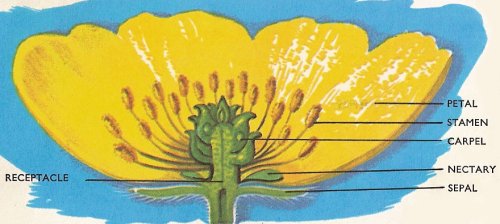
Figure 1. Longitudinal section of a buttercup, an hypogynous flower.
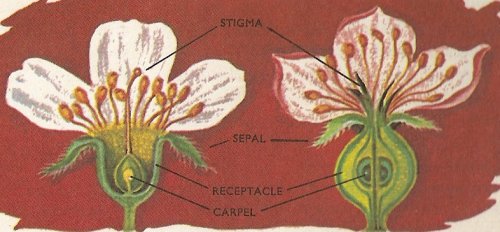
Figure 2. Plum flower (left). Although the receptacle has grown up around the carpel, the flower is still perigynous. The receptacle of the apple (right) has enclosed the carpels producing an epigynous flower.
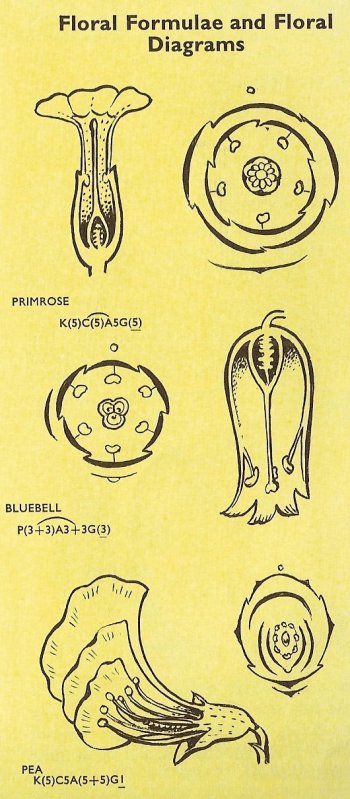
Figure 3. Floral formulae and diagrams.
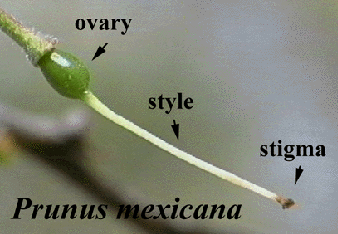
Figure 4. The gymnoecium of the Mexican prune.
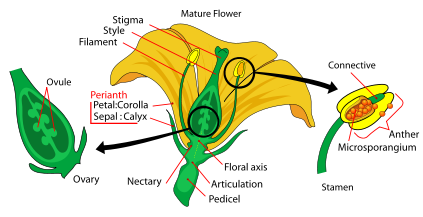
Figure 5. Parts of a mature flower.
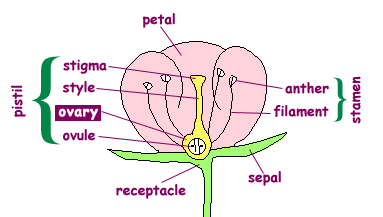
Figure 6. Location of ovary.
A flower is the part of an angiosperm (flowering plant) which is concerned with reproducing the species. A flower is essentially an unlengthened shoot whose leaves are modified to form the floral organs (petals, etc).
Close-up of a buttercup
The buttercup is a convenient, simple flower to study. The stalk of the flower is called the pedicel and is swollen at the tip forming the receptacle. During development of the flower the rapidly dividing cells of the growing tip produce the floral leaves in the same way that leaves are produced on ordinary stems. The floral leaves develop in more or less concentric circles (whorls), but in some of the more primitive flowers, such as the water-lily, the petals and other organs are arranged in a spiral on the receptacle. The first formed organs of the flower are the five sepals. These are on the lowest part of the receptacle and form the calyx. The sepals are green, leaf-like organs whose chief purpose is to protect the developing flower. Above the sepals are the five yellow petals each with a small pocket at its base which produces nectar and is called a nectary. The group of petals is called the corolla and, with the calyx, forms the perianth. The petals and nectaries attract insects and other animals to the flower and also help to protect the essential sexual organs within. These are two types of reproductive organs in the buttercup flower – the stamens and the carpels. The stamens are the male, pollen-producing organs and form the androecium. Each stamen consists of a stalk (filament) and an anther which is the pollen sac at the tip. The carpels form the gynoecium. Each carpel contains a female egg-cell or ovule which gives rise to a seed when fertilized by a male cell from a pollen grain. The stigma is the tip of the carpel through which the pollen grain gains access to the ovule. The buttercup flower has numerous stamens and carpels but this is not the case in all flowers.
Below the flower there may be one or two tiny leaves (bracteoles) on the pedicel. These are the very earliest of the floral leaves. The pedicel tip continues to grow after forming them but its growth almost ceases when the sepals are formed so that the floral organs are close together on the receptacle. In a flower such as the snowdrop the bracteole protects the flower until it opens. It can be seen as a green scale at the back of the flower. A leaf at the base of the flower stalk is called a bract.
Varieties of flower structure
The buttercup as we have seen has all four types of floral organ and the parts are arranged in a regular manner. The petals are all of the same size shape and a section cut down through the flower (a longitudinal section) will always produce two similar halves. There are, however, many variations on this structure in the plant kingdom. Many are concerned with pollination which is the transference of pollen from flower to flower. Pea-flowers and many orchids are highly irregular with very oddly shaped petals. There is in such cases only one line along which a section will produce two similar halves. Frequently the petals (and the sepals) join to form a tube which gives added protection and may also serve to hold nectar. Examples are the primrose and bluebell. The carpels are usually above the rest of the flower because of the manner of growth. This is the hypogynous condition but it is not universal. In some flowers the receptacle spreads at the top so that the petals, etc., surround the carpels (perigynous condition) while in others (e.g., the apple) the receptacle grows up around the carpels so that they are below the other parts (epigynous condition).
A monoecious plant is a plant in which in which the male and female organs are borne on the same plant, but in separate flowers. The male flowers bear stamens, and the female bear one or more carpels. Examples are oak, corn (Zea mays), and walnut. A dioecious is one in which in which the male and female organs are borne in separate flowers which are on separate plants. Examples are willow, hemp, and asparagus.
Any type of organ may may be absent from a flower. If there are no petals the sepals are often brightly colored (e.g., the marsh marigold). Flowers, especially those of trees (e.g. hazel), may be unisexual having only male or female parts in each individual flower. The stamens do not vary a great deal but may be joined to each other (e.g. sweet pea) or to the petals (e.g., primrose). The carpels may contain one or more ovules, each of which gives rise to a seed. The pea pod, for instance, is derived from a single carpel with several ovules. Carpels may be joined as in the bluebell or free as in the buttercup. The flowering plants are classified mainly according to the flower structure.
Inflorescence
Flowers are sometimes borne singly (e.g., anemone, tulip) but more frequently they occur in a group, called an inflorescence, whose appearance depends upon the amount and type of branching. There are however two basic patterns. In one – the racemose pattern – the main growing point of the stem goes on growing – or at least does not produce a flower. The flowers are produced laterally (on the sides) e.g., the bluebell, and the inflorescence is termed a raceme. If the flowers are not stalked it called a spike. An umbel is a special raceme in which the main tip stops growing and all the flower stalks develop at one level producing the familiar head of flowers such as is found in the hogweed and other hedgerow plants. The umbel must not be confused with the corymb, however. This is a raceme in which the pedicels are of different lengths so that the flowers all appear at one level. The grouping of the small flowers in this way makes them more attractive to insects. In the second basic pattern – the cymose pattern – the stalk does end in a flower after giving off one or two branches which also end in a flower after branching. The stitchwort is an example of a cyme.
Flowers of the family Compositae are very specialized. The dandelion "flower" is really a collection of tiny flowers (florets) on a flat disk or capitulum. Each floret contains sexual organs and is a complete flower. The calyx is represented by fine hairs which later develop and carry away the seed. Each dandelion floret has a flat blade or ligule but thistles have only tubular florets. Daises have both types – the outer florets have colored ligules to attract insects while the inner florets are tubular and produce pollen and nectar. The Compositae is a very widespread and successful family of plants.
Floral formulae and floral diagrams
Botanists do not need to have a lengthy description of a flower to understand its structure. They use a simple expression – the floral formula (Fig 3). This tells them the number of parts and a good deal about their arrangement.
The letters K, C, A, and G stand for calyx, corolla, androecium, and gynoecium, respectively. P (for perianth) is used if the sepals and petals are alike. The formula for a buttercup is K5 C5 A∞ G∞, where ∞ means "numerous". A line under the carpel figure means that the flower is hypogynous. Above the figure it indicates epigyny. Where parts are joined, brackets surround the figure. The formula does not give a complete description. A floral diagram and a section cut through the flower are required to make the structure quite clear.
The floral diagram consists of a plan view of the flower with the organs arranged on circles or spirals, showing the degree of overlapping, any fusion of parts or irregularity and the position relative to the main stem of the plant (indicated by a small circle). Bracts and bracteoles are also shown. The longitudinal section is necessary to show the degree of perigyny if any.
Parts of a flower
anther
The anther is the upper, usually yellow, part of the stamen of a flowering plant (the lower part being the filament). Anthers produce, contain, and distribute pollen. The pollen is formed within two chambers called pollen sacs, and the chambers themselves are located in two lobes.
androecium
The androecium is the male part of a flower, comprising a number of stamens, each consisting of a two-lobed, pollen-bearing anther on a thin stalk called a filament. The term androecium comes from the Greek andros oikia, meaning "man's house."
calyx
1. In botany, the calyx is the sepals of a flower, taken as a group. The calyx is usually green in color and protects the flower when it is in bud. When the flower opens, the calyx surrounds the carpels, petals, and stamens, and forms the outer whorl of the perianth.
2. In anatomy, the calyx is a cup-shaped part, especially any of the divisions of the pelvis of the kidney. Each calyx receives urine from the urine-collecting tubes in one sector of the kidney. (Plural calyces.)
carpel
A carpel is a female reproductive element of a flower. A carpel consists of a stigma (which receives pollen), a style, and an ovary (containing ovules). A group of carpels make up the gynoecium, the complete female reproductive structure within a flower.
corolla
The corolla is the petals of a flower taken as a group, especially the conspicuously colored flower whorl. Petals may be free or fused with one another or with the members of other floral whorls.
gynoecium
The gynoecium is the collective name for the female elements of a flower (Fig 4). The gymnoecium consists of the carpels, which, in turn, are made up of of the stigma, style, and ovary.
heterostyly
Heterostyly is a condition found in some angiosperms (flowering plants) of having styles of different lengths. The classic example of heterostyly is the primrose Primula vulgaris, in which there are two distinct flower forms, each occurring on different plants. Each form has a different-sized sty;le and stamen from the other so that pollen collected by insects from the anther of one type is dropped on the stigma of the other. Heterostyly increases the likelihood of cross-pollination because pollen cannot be passed between plants with sex organs of the same size.
ovary
In angiosperms (flowering plants), the ovary is the enlarged, hollow, basal portion of a carpel, which contains the ovule(s) (Fig 6). In a flower that has two or more united carpels the ovaries are united to form a single compound ovary. The ovary matures to become the fruit.
perianth
In angiosperms (flowering plants), the perianth is the petals and sepals taken together. The term comes from the Greek peri for "around" and anthos for "flower". Achlamydeous means to have no perianth (petals or sepals), as in the case of the flowers of a willow.
petal
A petal is a conspicuous flower part and one of the elements of the corolla – the petals of a flower taken as a group, especially the conspicuously colored flower whorl. Petals may be free or fused with one another or with the members of other floral whorls.
Surrounded by sepals, flower petals are usually brightly colored and often secrete nectar and scent to attract the insects and birds necessary for cross-pollination. Once fertilization has taken place, the petals usually drop off. The petals of wind-pollinated flowers are often small and inconspicuous, allowing the stamens and stigma to be exposed for pollination.
pistil
The pistil is the central, female organ of a flower, typically consisting of ovary, style, and stigma, which receives the pollen. A pistil may consist of one or more fused carpels and is more technically and better known as the gynoecium. A flower with carpels but no functional stamens is called pistillate.
sepal
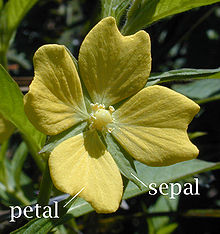 |
A sepal is a modified leaf and member of the outermost whorl of a flowering plant which surrounds the petals. Collectively, the sepals constitute the calyx. Although usually green and inconspicuous once the flower is open, in some species, such as orchids, the sepals look like the petals. In other species, such as anemones, the sepals are absent.
stamen
The stamen is the organ of a flower that produces the pollen (Figure 5). A stamen usually consists of an anther, in which the pollen is produced, on the end of a stalk-like filament. Collectively, the stamens make up the androecium. The arrangement and number of stamens is important in the classification of angiosperms (flowering plants).
style
In flowers, the style is the slender column of tissue that arises from the top of the ovary and through which the pollen tube grows.
stigma
In angiosperm flowers, the stigma is the region of a carpel that serves as a receptive surface for pollen grains.
A stigma is also the light-sensitive eyespot of some algae.


